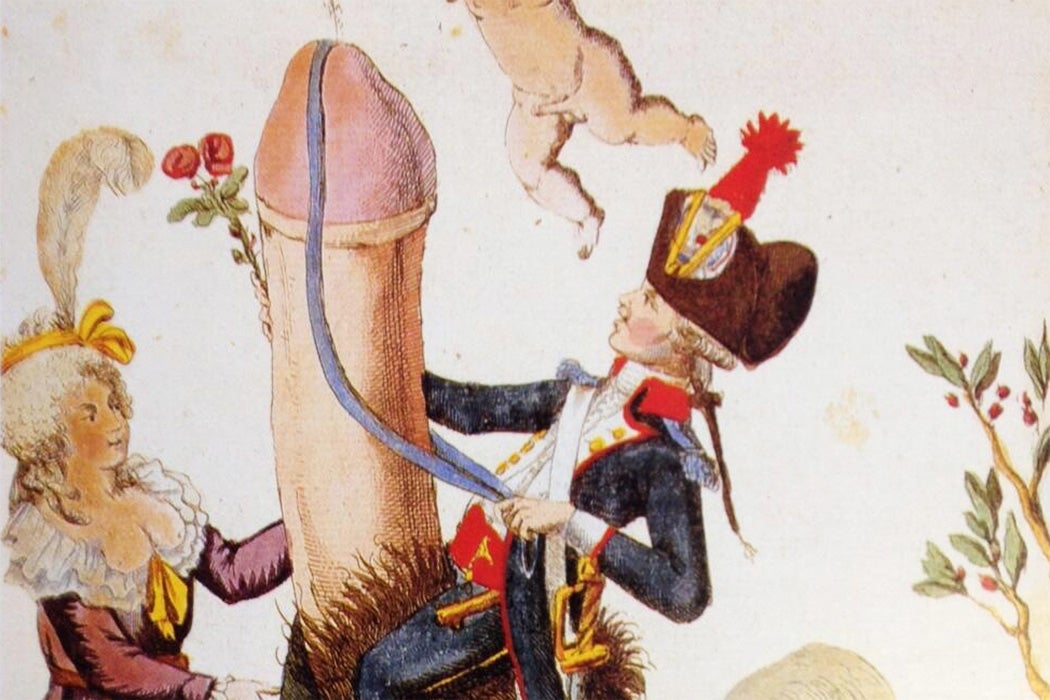“Racist humor reminds us of national difference and of prejudices we prefer not to admit but which continue to grip us,” writes performance and communication scholar Matt Jones. Laughter is the best medicine—for the ones who are doing the laughing—but how about for those who are the objects of derision?
Over the last few years, with the parallel rise of nationalism and social media as a stage for political participation, the spread of hateful ideas has been amplified, especially through humorous forms of communication such as memes. While memes are far from being the origin story of discriminatory humor, their proliferation and popularity reminds us that disparagement based on ascribed identities such as race, gender, sexual orientation, and so on can be normalized through everyday joking.
More to Explore
No Joke
Much of the scholarship that studies this “punching down” variety of humor relies on the superiority theory to explain how feelings of ethnic/racial superiority and hostility inform racist humor. Certain themes recur in this reading list: “us” versus “them” thinking that fuels stereotypical humor; humor’s ability to make hatred pleasurable (and even attractive); humor as a mechanism for race-based solidarity; and most significantly, humor as a mechanism through which violence is reduced to a laughing matter. Notably, participation in racist humor is not necessarily restricted to people who identify with any political affiliation. The ambivalence and ambiguity of humor allow it to tread where explicit hate speech cannot.
This list is primarily focused on North American and European mobilizations of discriminatory humor—often what is labeled as “ethnic humor.” The scholars represented in this reading list evaluate how allegedly harmless everyday practices—like sharing a joke—dehumanize the victims. The choice of articles in this list doesn’t imply that disparaging humor doesn’t occur in other historical and geographical contexts but simply offers a starting point to interrogate the social functions of racist humor. As always the JSTOR link—marked with the red letter “J” icon—are free for all to read and download.
Weekly Newsletter
Robert Hornback, “The Folly of Racism: Enslaving Blackface and the ‘Natural’ Fool Tradition,” Medieval & Renaissance Drama in England 20 (2007): 46–84.
Hornback’s analysis reaches back to Medieval and Renaissance drama, illustrating how Blackness was constructed as “naturally” foolish. He shows how these depictions were beneficial to white justifications of the transatlantic slave trade and how they served as a precursor to subsequent traditions of blackface comedy.
Lawrence E. Mintz, “Humor and Ethnic Stereotypes in Vaudeville and Burlesque,” Melus 21, no. 4 (Winter 1996): 19–28.
The peak of on-stage “ethnic humor”—from 1890 to 1910—was also considered the golden age of American vaudeville. Much of this humor was shaped by anti-immigrant sentiment. Mintz gives a brief overview of the varying ethnic stereotypes that circulated at the time and offers insight into why ethnic humor no longer found favor with vaudeville audiences by the end of the 1920s. Sharing diverse scholarly perspectives on the impacts of ethnic humor, he argues that assessing the social function of humor requires an understanding of “who says what to whom under what contextual circumstances.” He offers a pertinent reminder that the aphorism about being able to “joke about anything in the good ol’ days” isn’t true: the wrath of the United Irish societies brought down a Russell Brothers show.
Nicholas Sean Hall, “The Wasp’s ‘Troublesome Children’: Culture, Satire, and the Anti-Chinese Movement in the American West,”California History 90, no. 2 (2013): 42–67.
In the run up to the passing the Chinese Exclusion Act of 1882, satirical weekly The San Francisco Illustrated Wasp published “yellow peril” cartoons with increasing frequency. Hall explains how this state newspaper, published in multicultural California, was in alignment with the nationwide post-Civil War racial resentment. Run by an immigrant, The Wasp fueled the racist grievances of the West Coast’s white working class, which resulted in the banning of Chinese immigrants for sixty-one years. Hall sheds light on the efficiency of satire as a vehicle for violent ideologies, how the political agendas of publishers shape editorial stances, and how these xenophobic cartoons played into their profit motives.
Alan Dundes and Thomas Hauschild, “Auschwitz Jokes,” Western Folklore 42, no. 4 (October 1983): 56–66.
This text introduces the term “executioner’s humor” in reference to the anti-Jewish jokes being circulated in 1980s West Germany—jokes that made light of the atrocities committed against Jewish people during the Holocaust. The authors argue that these jokes allowed Germany to disassociate from the horrors of the Holocaust while simultaneously acknowledging its occurrence. Turkish immigrants were also the butt of jokes that combined antisemitic stereotypes with anti-immigrant antagonism. A short read, replete with examples that give insight into how German notions of Aryan purity and superiority were reinforced through these jests.
Limor Shifman and Elihu Katz, “‘Just Call Me Adonai’: A Case Study of Ethnic Humor and Immigrant Assimilation,” American Sociological Review 70, no. 5 (October 2005): 843–859.
Shifman and Katz provide a theoretical framework for analyzing immigrant assimilation humor. They argue that immigrant assimilation humor is different from other kinds of ethnic humor, in that the dominant group (typically the earlier immigrants), “abandons its own ethnic identity and assumes the role of standard-bearer for the nation.” In the case of this study, the Eastern European Jews who immigrated to Israel dropped their Eastern European identity to perform as Israeli when addressing Jews who immigrated from Western Europe.
Otto Santa Ana, “Did You Call In Mexican? The Racial Politics of Jay Leno Immigrant Jokes,” Language in Society 38, no. 1 (February 2009): 23–45.
Santa Ana argues that television host Jay Leno’s jokes that stereotyped Mexican immigrants allowed the audience to distance themselves from the circumstances and life conditions of the immigrants. The author articulates the influential role of late-night comedy in “priming” audiences on how to feel about issues that are making the headlines, especially because of its wide reach and the liberties extended to programs in the late-night comedy genre (relative to news programming).
Raúl Pérez, “Racism Without Hatred? Racist Humor and the Myth of ‘Colorblindness’,” Sociological Perspectives 60, no. 5 (October 2017): 956–974.
Pérez makes a strong argument for racist humor as a means of sustaining the false neutrality of white supremacist ways of thinking. A timely intervention into exposing the disingenuous of the “I don’t see color” assertion—a common denial of racist intent—by showing how participation in racist humor requires “color consciousness.” Case studies examined here include a mass market joke book marketed as an “equal opportunity offender” in this time of “political correctness” and the racist humor prevalent in the internal communications among law enforcement officers. Pérez shows how joking practices build community through the legitimization and strengthening of “common sense” notions of race and racism in daily life.
Matt Sienkiewicz and Nick Marx, “Beyond a Cutout World: Ethnic Humor and Discursive Integration in South Park,” Journal of Film and Video 61, no. 2 (Summer 2009): 5–18.
Sienkiewicz and Marx explore the complexity of ethnic humor by looking closely at a few episodes of the animated television series South Park. They argue that the context in which a show gets made, including the production schedule and the identity of the channel as well as the ways in which the gags reflect dominant media conversations about the topic, should be taken into account when assessing whether the jokes contribute to or destroy harmful stereotypes. To this end, they argue that South Park’s exaggerated depictions of Jews and Muslims motivate audiences to think critically about the ways in which they are presented in the media. However, they admit that due to its excessively satirical nature, it’s entirely possible that some of the narrative choices might affirm the very stereotypes the show hopes to debunk.
Simon Weaver, “Jokes, Rhetoric and Embodied Racism: A Rhetorical Discourse Analysis of the Logics of Racist Jokes on the Internet,” Ethnicities 11, no. 4 (December 2011): 413–435.
Weaver analyzes racist jokes on the internet from a rhetorical perspective; he takes a deep dive into the content and structure of these jokes. In doing so, he makes a strong connection between biological and cultural racism. His detailing of the inclusion and exclusion imperatives of the jokes can be especially helpful to scholars doing rhetorical analysis of media texts—even outside of humor.
Sahana Udupa, “Nationalism in the Digital Age: Fun as a Metapractice of Extreme Speech,” International Journal of Communication (2019): 3143–3163.
Based on ethnographic fieldwork among Hindu nationalists in India, Udupa contests the idea that “fun” in political participation is opposed to Habermasian ideals of rational public debate. Those who participate in the creation, curation, and sharing of disparaging memes defend these actions as merely rhetorical, having no material impact on the populations that are being targeted. Fun, Udupa argues, is thus a crucial element of online extreme speech because it allows users a similar sense of disavowal and detachment that accompany practices of objective deliberation.
Michael Billig, “Humour and Hatred: The Racist Jokes of the Ku Klux Klan,” Discourse & Society 12, no. 3 (May 2001): 267–289.
The advent of the internet gave KKK messaging a new lease of life, providing a venue to disseminate the white supremacist group’s ideas and a platform that enables them to defend these vitriolic ideas as “just a joke.” Through his in-depth analysis of KKK websites, veteran humor theorist Michael Billig illustrates how the dehumanization of Black people in these jokes contributes to the acceptability of violence against them.
Viveca S. Greene, “‘Deplorable’ Satire: Alt-Right Memes, White Genocide Tweets, and Redpilling Normies,” Studies in American Humor 5, no. 1 (2019): 31–69.
Greene shows how memes were strategically used to mainstream white supremacist messaging, capitalizing on the Trump presidential campaign’s anti-immigration and anti-establishment themes. She argues that the memes weaponized irony—typically a tool of progressive activism—to attract and radicalize supporters, creating a toxic counterpublic. She draws connections between the misogyny-driven Gamergate campaign and expressions of nationalist hatred, making explicit the ties between white nationalism and toxic masculinity. She also explains the logic of Poe’s Law, which applies to practices of online humor: the inability to tell whether it is a joke or meant to be taken seriously. The crucial takeaway here is that the social consequences of humor are more important than the intent behind it.
Matt Jones, “Vomiting on New Friends: Charlie Hebdo and the Legacy of Anarchic Black Humor in French Comics,” SubStance 46, no. 2 (2017): 71–94.
Matt Jones brings up the thorny topic of humor in relation to free speech by focusing on the French publication Charlie Hebdo and its controversial cartoons of Prophet Mohammed. Primarily writing on the history of anarchic humor in French bandes dessinées, Jones makes a comprehensive case for why humor can only be considered subversive if it goes against the established ideas of the time. This includes not attacking historically marginalized groups who are already suffer discrimination, often through the very stereotypes that form the bedrock of humor targeting them.
Deniz Göktürk, “Jokes and Butts: Can We Imagine Humor in a Global Public Sphere?,” PMLA 123, no. 5 (October 2008): 1707–1711.
What does it take to create genuinely subversive humorous cultural artifacts as opposed to reinforcing the status quo? Göktürk provides a brief overview of why and how we should start thinking about this question.
Support JSTOR Daily! Join our new membership program on Patreon today.








